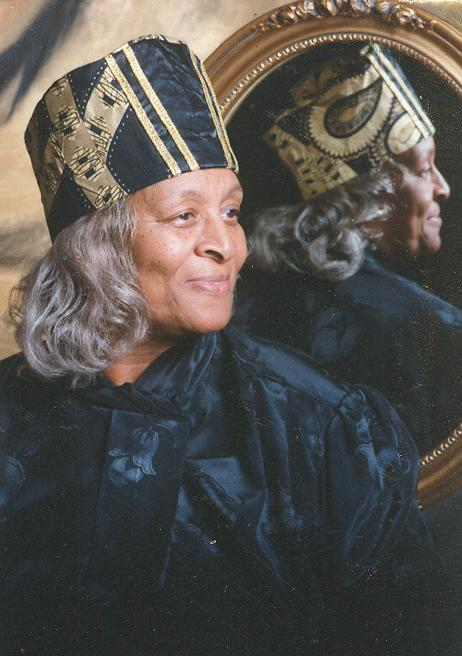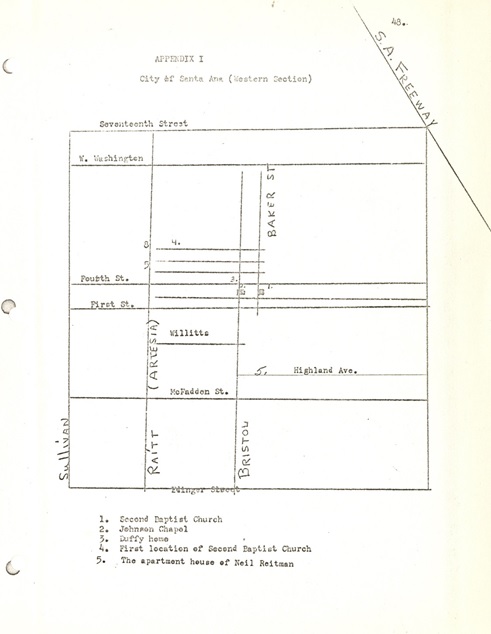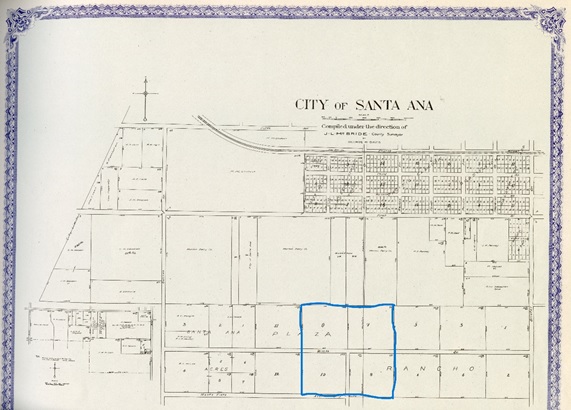Helen Shipp and Black History Square
Helen Marie Shipp

(born on April 1, 1935—died January 25, 2018) Helen Marie Shipp, Georgia-born Santa Ana resident, is known for her spirited determination, her role as president and co-founder of the Orange County Black Historical Commission and most notably for founding the Orange County's Black History Parade and Cultural Faire, known today as the Orange County Black History Parade and Unity Festival. Helen worked hard to promote, celebrate, and bring together the black community of Orange County. "I simply enjoy doing things that keep the black community recognized. We're just a part of this community as anyone else. So, why shouldn't we have the right to be seen as well?" (OC Register 1987).
From a young age, Helen would spend most of her time helping her mother with her volunteer work, demonstrating a sense of selflessness and benevolence towards others that would later benefit her life and her future mission. In 1946, Helen at the age of eleven moved from Detroit to Wayne, Michigan. There the neighbors were mixed, and everyone got along with each other. Even in Miami, Florida it wasn’t too bad, the worst thing is there were some places at one time, in [1952], you could not go eat. But then by 1955, you were able to do those things. But there was this thing – you couldn’t drink the water, the water fountain thing. “Colored over here,” would be the sign, and “whites over here” – that would be the sign. Helen lived in Miami until moving with her husband [they married in 1954] to Santa Ana in 1965, to what she called a “segregated Santa Ana.” Like many African Americans across the country, Helen would experience discrimination due to the color of her skin, but she would find solace within her community and churches around her area.
Helen founded the Orange County Black History Parade. The first parade was held in downtown Santa Ana on February 9, 1980. The next year the parade was held in the heart of Santa Ana’s black community and passed by many of the homes of black residents. The route's trajectory started in south Sullivan near Willits and circled around the northern part of the Jerome Center. That year’s event included a fair. Helen would face an uphill battle to get to this point, “In Miami, every December we'd have The Classics, which included an all-black parade, football game and dance," said Shipp. "So, I asked if there had been a black-history parade in Orange County and was told there had been one years before but that I shouldn't bother with organizing another one." (OC Register 1987).
 Helen founded the Orange County Black History Parade. The first parade was held in downtown Santa Ana on February 9, 1980. The next year the parade was held in the heart of Santa Ana’s black community and passed by many of the homes of black residents. The route's trajectory started in south Sullivan near Willits and circled around the northern part of the Jerome Center. That year’s event included a fair. Helen would face an uphill battle to get to this point, “In Miami, every December we'd have The Classics, which included an all-black parade, football game and dance," said Shipp. "So, I asked if there had been a black-history parade in Orange County and was told there had been one years before but that I shouldn't bother with organizing another one." (OC Register 1987).
Helen founded the Orange County Black History Parade. The first parade was held in downtown Santa Ana on February 9, 1980. The next year the parade was held in the heart of Santa Ana’s black community and passed by many of the homes of black residents. The route's trajectory started in south Sullivan near Willits and circled around the northern part of the Jerome Center. That year’s event included a fair. Helen would face an uphill battle to get to this point, “In Miami, every December we'd have The Classics, which included an all-black parade, football game and dance," said Shipp. "So, I asked if there had been a black-history parade in Orange County and was told there had been one years before but that I shouldn't bother with organizing another one." (OC Register 1987).
This statement inspired Helen to take up the challenge of organizing the first commission. “People thought I was crazy for going through with it; because all of the streets downtown were blocked off for only eight participants.” (OC Register 1987). Helen did not allow these setbacks to deter her.
While the first parade had a small turnout, the experience allowed her to evaluate and make improvements for future parades. In the months following the first Orange County Black History Parade, Helen reached out to the local churches, business leaders, and community activists to organize future parades. Helen continued to expand the Black History Parade and from 1980 to 1985, the parade expanded in the residential streets in the Jerome-Corbin neighborhood (now Bella Vista neighborhood). In 1986, the parade changed back to its original route down Main Street. The change in route increased both the number of entries to twenty-five with over twenty-thousand spectators.
Mrs. Shipp’s motto – “Honoring Our Heritage, Praising Our Present, Fortifying Our Future.”
Helen continued to participate in the parade until her passing on January 25, 2018. She was buried at the National Cemetery in Riverside, California. Mrs. Shipp was survived by her husband Felton Shipp, Sr. of 63 years at the time of her death and their ten children, the grandchildren, and the great-grandchildren. Helen’s legacy lives on with the next generation as her children and grandchildren continue her mission to organize the Orange County's Black History Parade and Unity Festival, with 2023 being its 43rd year, (30 years in Santa Ana, 1 year in Yorba Linda, and 12 years in Anaheim) not only in memory of their mother, but to preserve her mission of honoring their culture and helping to celebrate it with the Orange County community. Helen once said of the known, as well as the unknown, points of light in the black experience, "You look around and see the people you've touched touching others, and you realize it's a continuum that won't ever end." (OC Register, 2019).
A humanitarian at heart with a tenacious spirit, there is nothing Helen would not have done for her community. She believed in knowing our history, remembering the people of our past who helped shape our future. “It's important to know about history, because history goes on," said Helen. "I don't care what nationality you are - you need to know your own history and what we all have contributed in order to make America what it is." (OC Register 2009). We shall not forget this outstanding, kind, and determined woman who believed in her goals and saw things through even when faced with doubt and adversity, often telling others, "Nothing beats a failure but a try." (OC Register 1987)Shipp, Dwayne. Helen Shipp, photograph. Family Photos. March 15, 2023.
Black History Square

The Evolution of the African American Community in Santa Ana, California
The history of the African American community in Santa Ana, California, from the early 20th century through the mid-20th century is a story of migration, adaptation, and resilience. This period saw significant demographic shifts as African Americans moved from the rural South and Midwest cities to California, seeking better opportunities and a more open lifestyle. The evolution of this community in Santa Ana reflects broader themes of housing discrimination, economic challenges, and the pursuit of a cohesive social identity.
Early Settlers and Community Formation
Between 1910 and 1930, African Americans began to settle in Santa Ana, drawn by the promise of a better life. The initial settlements were concentrated along Bristol Street between Second and Fourth Street and along Artesia (now Raitt) between Fifth and Eighth Street. These areas, characterized by large, weeded lots and few houses, were considered countryside in the 1920s. The sparse population and the distance between neighbors allowed African Americans to rent or purchase homes, a significant change from the congested urban environments they had left behind in the Midwest.
The establishment of churches in these neighborhoods marked the beginning of a stable community nucleus. Churches such as Johnson Chapel, African Methodist Episcopal (AME) Church, and Second Baptist Church became central to social life, providing spiritual guidance, social interaction, and a platform for activism. Some of these early pioneers still reside in the same homes purchased 30 to 40 years ago, a testament to the lasting impact of these early settlements.
Employment and Lifestyle Changes
The move to Santa Ana brought significant lifestyle changes for many African American migrants. The openness and tranquility of Santa Ana were stark contrasts to the crowded and often harsh living conditions in the Midwest. This newfound environment led many to change their professions. Former farmers, railroad workers, and industrial laborers often took up custodial or domestic employment, allowing them to enjoy Santa Ana's spacious and serene lifestyle.
Housing Challenges and Discrimination
Despite the opportunities, African Americans in Santa Ana faced significant challenges, particularly in housing. Renting was difficult due to racial discrimination, as many Caucasians would not rent to African Americans. Frank Mussellman, an owner of several properties, was one of the few who would rent to African American families. Some older residents believe that Mussellman's willingness to rent to African Americans contributed to the early concentration of the community in the Fourth and Bristol and Artesia areas.
Before the landmark Supreme Court case Reitman v. Mulkey in 1967, black residents in Orange County were largely confined to buying or renting homes in an area of Santa Ana known as "Little Texas." This restriction was a direct result of Proposition 14, a backlash against the Rumford Fair Housing Act of 1963, which allowed property owners to discriminate based on race. Through the efforts of community activists like Dorothy and Lincoln W. Mulkey, Black families challenged these discriminatory practices. Mulkeys' successful lawsuit overturning Proposition 14 was a significant victory that opened up housing opportunities for black residents in Orange County.
Post-War Growth and Expansion
During World War II, increased job availability led to more African Americans moving to Santa Ana. The small, tight-knit community in Santa Ana saw dramatic growth between 1940 and 1950, experiencing a 300% increase in population and expanding beyond its original nucleus. African Americans started buying homes along Sixth, Seventh, and Eighth Streets between Bristol and Raitt, areas previously dominated by Caucasians.
In 1954, the community began moving toward the southern part of the city, a shift driven by the desire for a cohesive community. The area along Bristol to McFadden and west to Sullivan became a new hub for the African American population. As one pioneer noted, "That was their own idea. They were not confined to this area and no one told them they had to live together."

The Civil Rights Movement in Santa Ana
In the 1960s, Santa Ana's Black community was a microcosm of the broader civil rights struggle across America. The community organized to address various forms of discrimination, including unfair housing practices. Among the prominent figures in this community were T. Leon Berry and Joe Albert Jeffrey, two men who lived next door to each other in Santa Ana and witnessed firsthand the struggles and triumphs of the civil rights movement. They established a fair housing council and conducted tests to expose landlords who refused to rent or sell to black families.
Reactions to King's Assassination
The news of King's assassination was met with profound sadness and a sense of injustice among Santa Ana's black residents. While many black communities across the country reacted with violence and riots, Berry and Jeffrey recall that Orange County did not experience such turmoil. Instead, there was a shared feeling of betrayal and frustration.
One notable incident that Berry and Jeffrey recall was the protest against the Santa Ana Register's refusal to lower its flag in honor of King. The refusal by R.C. Hoiles, the owner of the Register, sparked a small but significant protest organized by the local NAACP. Although their march attracted little attention, it symbolized the community's commitment to honoring King's legacy and their unwillingness to let his assassination go unnoticed in Orange County.
Conclusion
The evolution of the African American community in Santa Ana from 1910 to 1960 showcases the resilience and determination of its early settlers. Despite facing significant barriers in housing and employment, they managed to build a vibrant and strong community with enduring institutions like churches and social organizations. The population growth in the mid-20th century highlighted Santa Ana as a key destination for African Americans seeking a better life in California, contributing to the broader narrative of African American migration and settlement in the United States.
Reference Works
Batchelor, Marilyn A., Helen Shipp: Group Leader puts Black.” The OC Register. August 26, 1987, sec. Local.
Bharath, Deepa. “Parade Celebrates Black Heritage.” The OC Register. February 3, 2013, sec. Local.
Johnson Robert A and Charlene Riggins. 2009. A Different Shade of Orange : Voices of Orange County California Black Pioneers. 1st ed. Fullerton: California State University.
Mahlberg, Jean. “The History and Development of the Negro Community in Santa Ana, California.” Unpublished Thesis. 1967.
Robinson, Alicia. “The 82-Year-Old Shipp, Who Founded the Parade in 1980, Died an. 25.” The Orange County Register. February 4, 2018, sec. Celebration.
Walker, Theresa. “Santa Ana Neighbors Recall Day King Died.” The Orange County Register. 2011. https://www.ocregister.com/2011/04/04/santa-ana-neighbors-recall-day-king-died/
